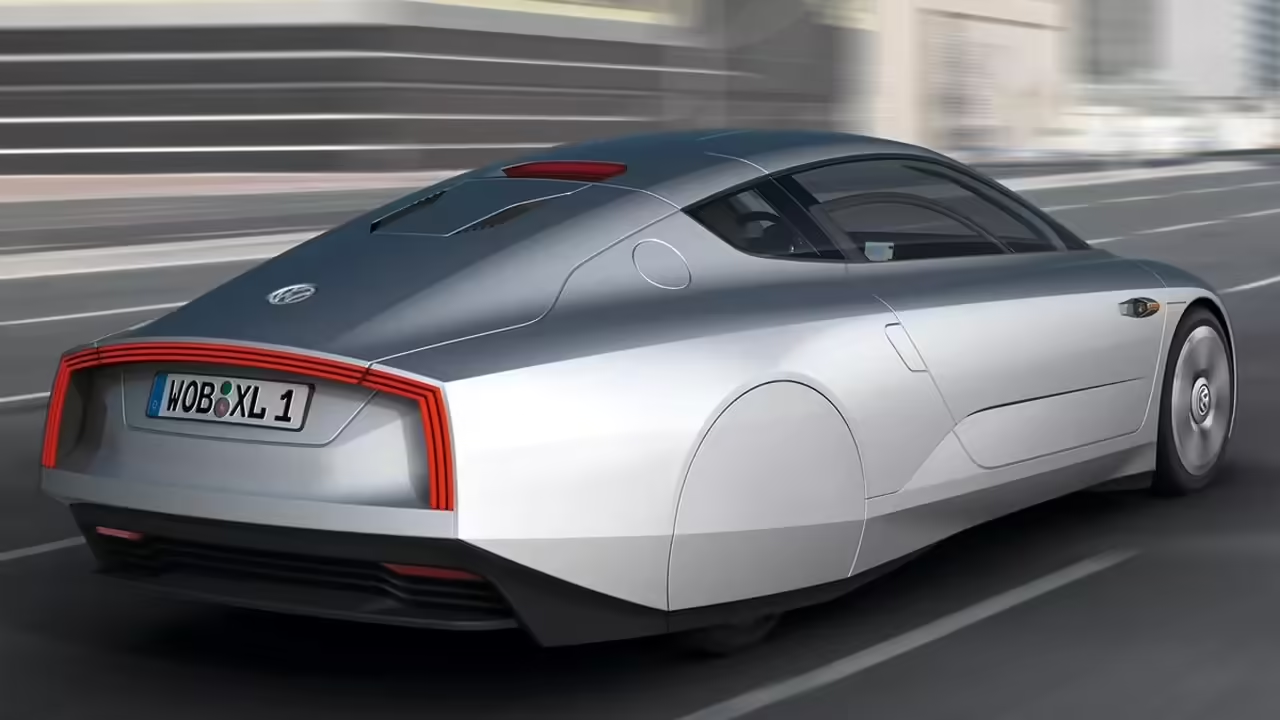
The Volkswagen XL1 is a revolutionary car in terms of energy efficiency and design. This plug-in hybrid vehicle was first unveiled in 2011 at the Qatar Motor Show, and has since attracted the attention of the public and the automotive industry for its incredible fuel economy.
The Volkswagen XL1 was designed to be an ultra fuel-efficient car. According to the company, the XL1 can travel 100 kilometers on just 1 liter of fuel. This impressive figure is due to a combination of factors, including advanced aerodynamic design, a plug-in hybrid engine and light weight.
The XL1’s aerodynamic design is one of its highlights. The car has a drag coefficient of only 0.189, making it one of the most aerodynamic vehicles in the world. In addition, the XL1 is made of lightweight materials, such as carbon fiber and aluminum, reducing its overall weight to just 795 kg.
The XL1’s plug-in hybrid powertrain consists of a 27-horsepower electric motor and an 800 cc diesel engine with an output of 47 horsepower. The electric motor is powered by a 5.5 kWh lithium-ion battery, which can be charged from a household outlet in a few hours. The diesel engine, meanwhile, is designed to be as efficient as possible, with a 14:1 compression ratio and a high-pressure fuel injection system.
Together, these elements make the Volkswagen XL1 capable of a top speed of 160 km / h and accelerate from 0 to 100 km / h in 12.7 seconds. However, the real strength of the XL1 is its incredible fuel economy, which translates into a consumption of 0.9 liters/100 km in hybrid mode and 0 liters/100 km in electric mode, thanks to its electric range of up to 50 km.
The Volkswagen XL1 is an exceptionally advanced and efficient car, but it is also a showcase of the automotive industry’s ability to innovate and create sustainable and efficient solutions. As technology advances and environmental challenges become increasingly urgent, we are likely to see more cars like the XL1 in the future, with the promise of a cleaner and more sustainable future.
The Future of Efficiency: The Volkswagen XL1 prototype
Energy efficiency is an increasingly important topic in the automotive world as consumers look to reduce their carbon footprint and save on fuel costs. The Volkswagen XL1 prototype is an example of how automakers are innovating to create more efficient and environmentally friendly vehicles.
The Volkswagen XL1 is a plug-in hybrid that uses an 800cc diesel engine and an electric motor to achieve amazing fuel efficiency. According to the company, the XL1 can travel 100 kilometers on just 1 liter of fuel. This is achieved through a combination of factors, including advanced aerodynamic design, light weight and cutting-edge propulsion technology.
One of the highlights of the XL1’s design is its drag coefficient of just 0.189, making it one of the most aerodynamic vehicles in the world. In addition, it is made of lightweight materials such as carbon fiber and aluminum, reducing its overall weight to just 795 kg.
The XL1’s diesel engine is highly efficient, with a compression ratio of 14:1 and a high-pressure fuel injection system. The electric motor, meanwhile, is powered by a 5.5 kWh lithium-ion battery that can be charged in just a few hours from a household outlet.
Together, these elements make the Volkswagen XL1 capable of reaching a top speed of 160 km/h and accelerating from 0 to 100 km/h in 12.7 seconds. But most impressive is its fuel economy, which translates into a consumption of only 0.9 liters/100 km in hybrid mode and 0 liters/100 km in electric mode.
The Volkswagen XL1 prototype is an example of how automakers are innovating to create more efficient and environmentally friendly vehicles. As technology advances, we are likely to see more vehicles like the XL1 in the future, offering a sustainable and economical solution for consumers looking to reduce their carbon footprint. With increased environmental awareness and a focus on energy efficiency, the future of the automobile looks brighter than ever.
Volkswagen XL1 plug-in hybrid technology
The Volkswagen XL1’s plug-in hybrid system combines an electric motor with a diesel engine for impressive efficiency. The two-cylinder, 0.8-liter diesel engine is rated at 47 horsepower and is mated to a seven-speed dual-clutch transmission. The electric motor is rated at 27 horsepower and is powered by a 5.5 kWh-capacity lithium-ion battery.
Volkswagen’s XL1 can be driven in electric mode, which means that the diesel engine is not used at all. In this mode, the vehicle has an electric range of up to 50 km. If the battery is depleted, the diesel engine automatically switches on to recharge the battery and provide the power needed to continue driving.
When both engines are running, the diesel engine acts as a generator to charge the battery and provide power to the electric motor. It also provides additional power to the electric motor in situations where rapid acceleration or increased power is needed, such as on a steep climb.
The XL1’s plug-in hybrid system also uses energy recovery technology, which means that energy generated during braking is used to recharge the battery rather than being dissipated as heat. This helps extend battery life and further improves vehicle efficiency.
Innovations in the automotive industry
The automotive industry is undergoing a number of innovations to improve efficiency and reduce environmental impact. Some of the most prominent innovations include:
Electric vehicles: electric vehicles are becoming more common and are an effective way to reduce greenhouse gas emissions and improve efficiency.
Hybrid technology: Hybrid vehicles combine a gasoline engine with an electric motor to improve efficiency and reduce emissions.
Fuel cell technology: vehicles with fuel cell technology use hydrogen to generate electricity, which reduces emissions and improves efficiency.
Lighter materials: Automakers are using lighter materials, such as carbon fiber and aluminum, to reduce vehicle weight and improve efficiency.
As for Volkswagen’s XL1, it is a plug-in hybrid vehicle that combines a two-cylinder diesel engine with an electric motor. The XL1 is exceptionally energy efficient, with fuel consumption of around 0.9 liters per 100 kilometers driven and CO2 emissions of only 21 grams per kilometer. Compared to other vehicles on the market, the XL1 is one of the most efficient vehicles with the lowest environmental impact.
Today, the automotive industry is facing increasing pressure to reduce greenhouse gas emissions and improve vehicle efficiency. Technological advances are enabling automakers to produce cleaner and more efficient vehicles, and even more advanced innovations are expected to continue to be developed in the coming years.
For example, electric vehicles are becoming increasingly popular because they emit no polluting emissions and are more efficient than conventional vehicles. In addition, hybrid vehicles and vehicles with fuel cell technology are offering viable alternatives to gasoline and diesel vehicles.
Another approach to reducing the environmental impact of vehicles is the use of lighter materials in vehicle construction. Carbon fiber, aluminum and other composite materials can significantly reduce vehicle weight, which in turn improves efficiency and reduces emissions.
Volkswagen XL1 cost and availability
The Volkswagen XL1 was produced in a limited edition of 250 units, so its availability in the market is very limited. In addition, the model was introduced in 2013 and its production ceased in 2016, so it is no longer for sale as a new vehicle in dealerships.
In terms of cost, the Volkswagen XL1 was one of the most exclusive and advanced models produced by Volkswagen, so its original selling price hovered around €110,000. However, since it is no longer for sale as a new vehicle, prices of the Volkswagen XL1 on the used market can vary significantly.
In general, due to its limited production and advanced technology, the Volkswagen XL1 is considered an exclusive and high-end vehicle, making it not accessible to the general public. However, its technological advances and efficiency have influenced the development of other models that are more accessible to the general public, especially with regard to the reduction of greenhouse gas emissions and the use of hybrid and electric technology.
Volkswagen XL1 driving experience
The Volkswagen XL1 driving experience is unique in that it is a vehicle designed for maximum efficiency and reduced carbon emissions. As such, the XL1 focuses on efficiency rather than speed and power.
In terms of handling, the XL1 is quite agile thanks to its low weight and center of gravity. The vehicle feels light and easy to handle in curves and tight spaces.
Compared to other models, the XL1 is unique in its focus on efficiency and emissions reduction, making it incomparable to conventional vehicles in terms of drivability. In terms of comparison to other hybrid and electric vehicles, the XL1 has exceptional efficiency thanks to its ultra-lightweight construction and aerodynamic design, making it one of the most efficient vehicles on the market. However, in terms of power and speed, the XL1 may lag behind other sport and high-powered vehicle models.
The Volkswagen XL1 uses specially designed tires to maximize efficiency and reduce rolling resistance. These tires are made of lightweight materials and feature a low-rolling resistance tread design, which helps reduce the amount of energy needed to roll the vehicle.
In addition, the XL1’s tires have higher-than-normal inflation pressure, which also helps reduce rolling resistance and improve fuel efficiency. The vehicle also features tire pressure monitoring systems to ensure that the tires are properly inflated at all times.
Importantly, the XL1’s tires are undersized, measuring 115/80 R15 in the front and 145/55 R16 in the rear. This is because smaller tires have less air resistance and less moving mass, which improves vehicle efficiency. However, due to their small size, XL1 tires may not be suitable for all driving conditions and terrains, so it is important to consider when choosing a vehicle suitable for each driver’s needs.







